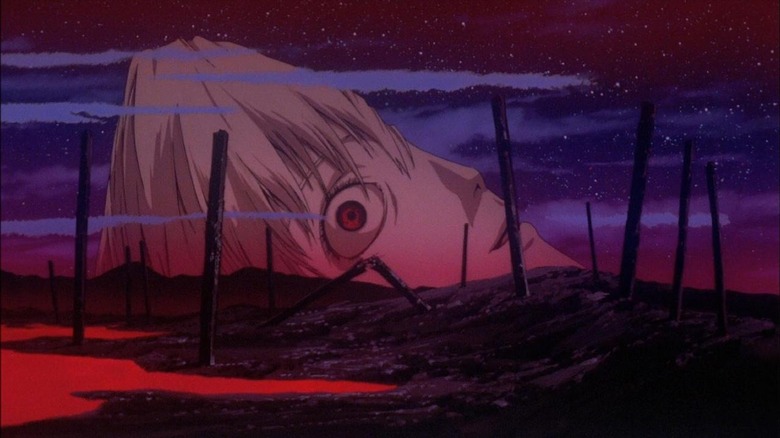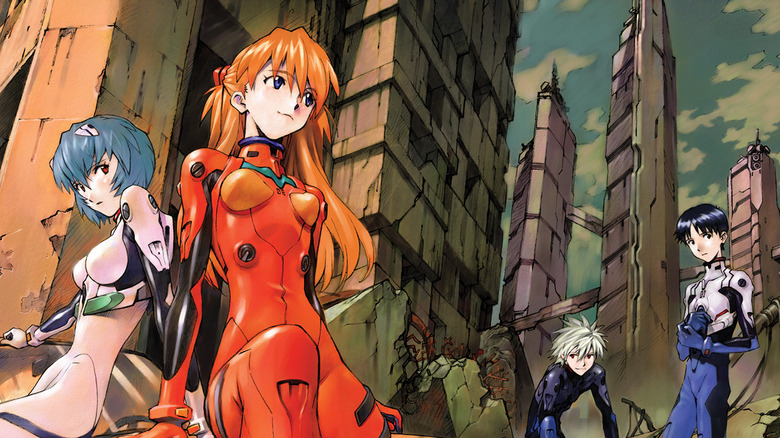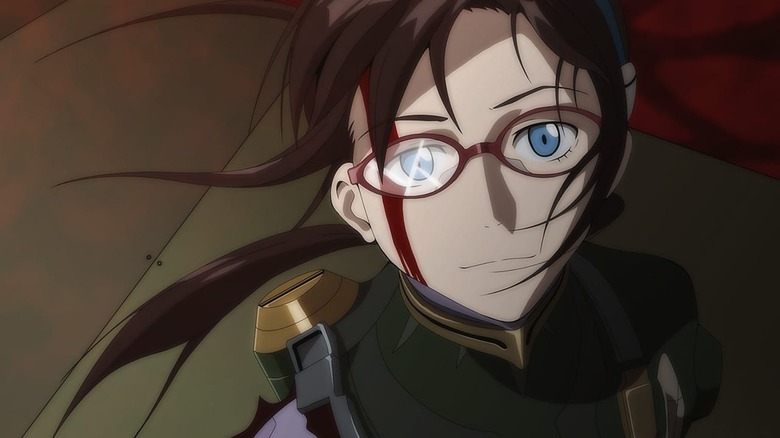The Correct Order In Which To Watch Neon Genesis Evangelion
If one were to poll anime fans on what series other fans absolutely had to watch, "Neon Genesis Evangelion" would be high up there. For any anime to remain popular decades after its original release — not to mention after its original predicted the apocalypse year of 2015 — it has to be something special. The story of a group of emotionally troubled teenagers forced to pilot the Evangelions (giant robots — or are they?) to defeat monstrous Angels and prevent (or cause?) the end of the world has captivated, befuddled, and moved many generations of otaku. Even as the mecha genre fades in popularity, the influence of "Evangelion" on the anime industry is still clearly visible.
Compared to some anime that run for thousands of episodes, the time commitment to fully experience "Evangelion" is relatively tiny: just a TV series and some movies, plus assorted multimedia spinoffs for those who get really obsessed to enjoy. Yet even with relatively little anime to watch, people might be uncertain about the correct order to watch it in, given all the controversies surrounding the various alternate endings and a lack of clarity on whether the "Rebuild of Evangelion" movies are a remake or a sequel (turns out they're a bit of both). For those ready to start their journey into Tokyo-3 and experience "Evangelion" for the first time, this guide should clarify all potential confusion about the proper viewing order.
Watch the original TV series first
Anyone trying to get into "Neon Genesis Evangelion" must start with the original 26-episode anime series that first aired on Japanese TV from 1995-6. This show changed anime forever, taking the classic tropes of the mecha genre and twisting them into stranger psychological territory. What starts as a thrilling, somewhat mysterious "monster of the week" series grows into an increasingly complex, deeply personal reflection of creator Hideaki Anno's struggles with depression. All of it is worth watching — even the controversial final two episodes, which abandon traditional storytelling altogether in favor of abstract limited animation, are something every serious anime fan needs to see, if only for the sake of having an informed opinion on them.
The series is easy to stream worldwide on Netflix — though the streaming service could not afford the rights to the original ending themes (all different covers of "Fly Me to the Moon") outside of Japan, and some fans have questioned the overly literal translation choices in Netflix's new dub and subtitle tracks. The older English translation from ADV Films can be found on the limited-run "Neon Genesis Evangelion" Ultimate Edition Blu-Ray sets from GKIDS.
Evangelion:Death(True)2 is a skippable recap
"Neon Genesis Evangelion: Death & Rebirth" came out in 1997, and was the first movie in the "Evangelion" franchise — offering little more than a pure cash grab that holds no value today. The "Death" section of the film, which is streaming on Netflix under the title "Evangelion: Death (True)2," is a 68-minute clip show of the TV series first 24 episodes. The "Rebirth" section of the film, which is no longer in circulation, is literally just the first 24 minutes of "The End of Evangelion," which was released in Japanese theaters three months later.
If "Death & Rebirth" had any purpose after the release of "The End of Evangelion," it was due to the inclusion of at-the-time new, extended, or reanimated scenes in the "Death" section. That purpose disappeared once these fresh scenes were added to the "Director's Cut" home video releases of "Neon Genesis Evangelion" Episodes 21-24. These director's cuts are the only versions of the episodes streaming on Netflix, removing any need for all but the most hardcore completionists to bother watching "Evangelion: Death (True)2."
The End of Evangelion is Evangelion's second ending
If the limited scope and no-budget animation of the TV series final two episodes frustrated you, the 1997 movie "The End of Evangelion" delivers a fuller, more dramatically conclusive resolution to the story — though it may frustrate you for completely different reasons. "Neon Genesis Evangelion" had already taken many dark turns in its latter half, but "The End of Evangelion" goes to another level with its phantasmagorically brutal depiction of the Third Impact apocalypse.
Parts of the movie were allegedly planned to be included for the TV series ending before schedule and budget issues got in the way; people have interpreted events of the film as happening externally at the same time Episodes 25 and 26 are happening internally in Shinji's mind. Other parts of the movie are a direct response to the vitriol Anno faced over the TV ending — look closely at some of the montages and you'll find the death threat letters he got. Filled with deaths of beloved characters and more extreme violence and sexual content than the show could get away with, it's a challenging watch, but also a powerful one, with some of the most frighteningly stunning animation ever put to screen.
BONUS: the Manga is an alternate take on the story
Though "Neon Genesis Evangelion" was one of the rare franchises created initially for anime, the manga adaptation by character designer Yoshiyuki Sadamoto actually started publication in December 1994, almost a year ahead of the show's heavily delayed broadcast. This publication would also continue long after the show was complete, sporadically releasing new chapters up until 2013.
Though it follows a similar chain of events to the TV series, the "Evangelion" manga is in its own separate continuity with different interpretations of the characters and, as expected from any new version of "Evangelion," a different ending. Because it's so different and separate, there's not a clear place to put it in terms of any specific order of what to watch or read first, but it's an interesting alternative take for those who chose to read it, with some fans preferring its more positive tone and somewhat more emotionally stable characters over the anime. Viz Media published all 14 volumes of the manga in English.
BONUS: weird non-canonical spinoffs
There's a ton of "Evangelion" esoteric with no impact on the mainline anime and is really intended only for those who are already hardcore fans. It would be pointless to make a viewing or reading order for these non-canonical spinoffs unless you wanted to go purely by chronological order of release. We've placed this entry after the original series but before the "Rebuild of Evangelion" movies to emphasize just how omnipresent the series was in Japanese pop culture — even before the reboot.
Did you like the scene in Episode 26 where we see an alternate universe where Shinji and the other pilots are just ordinary high schoolers? There are a lot of spinoffs based around that universe, including the manga series "Angelic Days" and "The Shinji Ikari Raising Project," the latter of which also has a video game. Want your high school antics to be even sillier? There's the chibi-style "Petit Eva" sub-franchise, which consists of manga, CGI web anime, and a Nintendo DS game.
For some reason, people like seeing the "Evangelion" characters involved in detective mysteries — thus the manga "The Shinji Ikari Detective Diary" and the "Ace Attorney" rip-off PS2 game "Detective Evangelion." "Evangelion" video games have taken on many different genres, from rhythm games, dating sims, typing games, and even a virtual pet of Adam. For a reminder that "Evangelion," despite its extreme content, is still somehow marketed towards children, watch the crossover episode of the kiddy anime "Shinkalion" where Shinji Ikari shows up.
Evangelion 1.11 remakes the first few episodes
After "The End of Evangelion," Anno moved on to other projects, directing part of the shojo romcom "His and Her Circumstances" and several live-action movies. Eventually, he returned to his most famous creation with "Rebuild of Evangelion," a quadrilogy of movies retelling the story of the original series with a new ending. The first installment of the new series, "Evangelion: 1.11 You Are (Not) Alone," was released in Japanese theaters in 2007. All four of the "Rebuild" moves are available to stream worldwide on Prime Video.
This first "Rebuild" movie is essentially a condensed creation of the first six episodes of the TV anime with new digitally enhanced animation. Based on this installment alone, viewers of the TV series might assume the "Rebuild" series doesn't have much new to offer, while newcomers might think they can watch this faster and shinier version in place of the original series without missing much. However, the subsequent "Rebuild" films go in different enough directions that old-school "Evangelion" fans will get a lot of new stuff out of them, and the way the "Rebuild" films respond to the previous installments means newcomers are advised to wait until after completing the original series and "The End of Evangelion" to watch them.
Evangelion 2.22 shifts things in a new direction
"Evangelion: 2.22 You Can (Not) Advance," the second "Rebuild of Evangelion" movie, is where things start to change significantly from the original series. You'll still recognize some familiar scenes in this 2009 release, but many others are remixed in interesting and surprising ways, and other elements are brand new to this version.
The most obvious new addition right from the start is the introduction of a new EVA pilot, Mari Illustrious Makinami. She stands out from the rest of the cast as the only person who seems to actually enjoy getting in her robot. New Angels also appear in some spectacular battle scenes, and the characters fans already know and love (or love to hate) get developed in different directions from their TV incarnations. Shinji in particular is a more proactive protagonist this time around, which leads to intense consequences at the film's cliffhanger ending. However, if you're looking forward to a direct continuation from that cliffhanger in the next film, prepare to measure your expectations.
Evangelion 3.33 ups the controversy
If the first two "Rebuild of Evangelion" movies seemed like attempts at a more commercial and easily digestible version of the story, then 2013's "Evangelion: 3.33 You Can (Not) Redo" comes as a harsh reminder that the crew behind these movies may not want you to understand everything. The third "Rebuild" starts 14 years after the previous film, though the EVA pilots remain physically the same age due to a "curse." Third Impact has already occurred, and there's a ton of technobabble and political infighting as both Shinji and the viewers struggle to keep up with it all.
The strongest part of "Evangelion 3.33" are easily the scenes between Shinji and Kaworu, the potential love interest and tragic Angel who only appeared in Episode 24 of the TV series. Kaworu left a huge impression in the original despite minimal screen time, and getting more chemistry between him and Shinji is a good thing. Of course, more time with Kaworu makes his ultimate fate all the more tragic. This is "Evangelion" in depression mode, and the final installment had its work cut out for it to find a hopeful resolution. Somehow, it found one.
Evangelion 3.0+1.0 delivers the last word on Shinji's story
Anno once again fell into a serious depression after the release of "Evangelion 3.33," and the final "Rebuild of Evangelion" film was delayed many times as a result. Fortunately, these delays were worth it, as 2021's "Evangelion: 3.0+1.0 Thrice Upon a Time" manages to be the ideal ending not only to the "Rebuild" series but to the entire "Neon Genesis Evangelion" franchise, at least as far as Shinji's story and Anno's direct involvement is concerned.
Running an epic 155 minutes, "Evangelion 3.0+1.0" is willing to take its time, where the previous "Rebuild" films could feel rushed. The first hour takes place mostly on a farm, giving plenty of time to see different sides of Shinji, Rei, and Asuka before they must once again pilot the EVA Units in hopes of averting the apocalypse. The over-the-top fight scenes remix imagery from "The End of Evangelion" in exciting new ways, and the whole of "Evangelion" is situated in a meta context of continual reboots and reimaginings. Somehow, the film accomplishes the last thing anyone expected from "Evangelion": an ending that's both happy and dramatically satisfying.
BONUS: the rest of Anno's Shin Japan Heroes Universe
Between the third and fourth "Rebuild of Evangelion" movies, Anno went in a perhaps unexpected direction, co-directing 2016's "Shin Godzilla" along with "Evangelion" storyboard artist Shinji Higuchi. This creative reimagining of Japan's most popular kaiju, inspired heavily by Japan's response to the 2011 Fukushima nuclear disaster, was the most critically acclaimed Godzilla film in a long time.
After finishing "Rebuild of Evangelion," Anno had a hand in rebooting two more favorite fantasy characters from his childhood in 2022's "Shin Ultraman" (Anno wrote and produced, while Higuchi directed) and 2023's "Shin Kamen Rider" (both written and directed by Anno). Fans of "Neon Genesis Evangelion" should check out all of these films, not only because they carry Anno's signature as an auteur and contain references to "Evangelion," but because they are technically a shared universe.
To be clear, the Shin Japan Heroes Universe isn't a cinematic universe of crossovers akin to the Marvel Cinematic Universe, but rather a construct of merchandising. Lots of cool crossover merchandise of the four iconic properties are being made, from amusement park rides to a toy that combines all four "heroes" into a Voltron-esque giant robot. Watching these films is an exciting and surprising way to carry on your love of all things "Evangelion."










